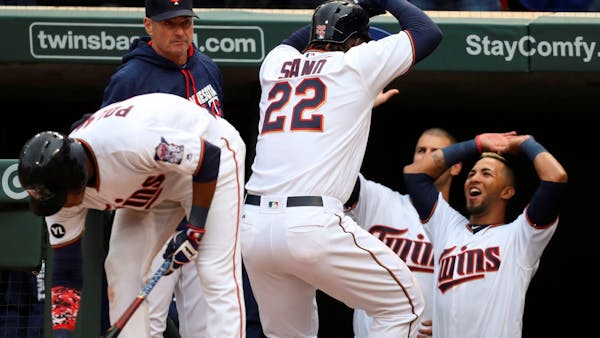Like movies, catches are now rated by stars and Byron Buxton produced the baseball season's first must-see catch on Opening Day.
The Twins center fielder's diving grab in the third inning of a 7-1 victory over Kansas City earned a perfect five-star rating, according to MLB Network's Statcast.
Royals All-Star Alex Gordon's liner in his second at-bat had just a 24 percent catch probability. The batted ball had an exit velocity of 106 mph and traveled 289 feet, yet Buxton tracked it down by traveling 36 feet in 2.9 seconds.
So what is Statcast and its new metric of catch probability?
Statcast is Major League Baseball's way of analyzing players' performance through technology. Catch probability is the newest metric that shows the likelihood of an outfielder making a play based on the distance he needs to travel and the time he has to cover that ground.
"Statcast, a state-of-the-art tracking technology, is capable of gathering and displaying previously immeasurable aspects of the game," MLB.com explains.
"Statcast collects the data using a series of high-resolution optical cameras along with radar equipment that has been installed in all 30 Major League ballparks. The technology precisely tracks the location and movements of the ball and every player on the field at any given time.
"The result is an unparalleled amount of figures and information, covering everything from the pitcher to the batter to any defensive players -- and everything in between. Statcast has been deemed by MLB Network analyst Brian Kenny to be 'a revolutionary technology that will change the way fans around the world view our national pastime.' "
These figures also identify flaws in what otherwise might have been considered a five-star catch to the fans. Buxton made a second diving catch in the fifth inning Monday, but most of the difficulty was created because of his own mistake. He stepped back and slipped before recovering to make the play that had a 98 percent catch probability.
According to Statcast, Buxton needed to cover 50 feet to reach the ball, but actually ran 64 because of the bad read.
MLB.com explains, "With Statcast tracking the exact start position on the field for each fielder and also measuring the hang time of each batted ball, the two most important pieces of data to define the difficulty of a catch opportunity are: 1. How far did the fielder have to go? 2. How much time did he have to get there?
"Accordingly, each tracked batted ball to the outfield is assigned an expected Catch Probability percentage -- relative to comparable catch opportunities in the Statcast era -- based on distance needed and opportunity time. The more time a fielder has to react to a ball and the less distance needed to reach it, the higher the Catch Probability.
"Distance needed is used instead of distance covered, which measures the ground a fielder covers from the point the ball is struck to the time the play is made, to prevent fielders from receiving additional credit for taking longer-than-necessary routes to the ball. Meanwhile, opportunity time is calculated from the point the ball leaves the pitcher's hand (rather than when the batter makes contact) to credit instances in which a fielder adjusts his position based on where the catcher sets up or what type of pitch is called."
Buxton converted 24 percent of his five-star chances in 2016 with six top-rated catches. The Twins led in the majors last season with 18 five-star catches.
"Us outfielders have this thing where nothing falls but raindrops," Buxton told MLB.com. "We take that to heart and want to be the best outfield out there. We're trying to be aggressive to every line drive and foul ball we can be. We know we'll have backup, so it allows us to play freely."
AP Sports Week in Pictures: Pitcher Randy Vazquez, Olympic flame and Nelly Korda's pond splash

Vikings look good at linebacker, but there's one issue to solve

Towns finds joy trying to stop 'best of the best' in Durant
Police clear out a migrant camp in central Paris. Activists say it's a pre-Olympics sweep

